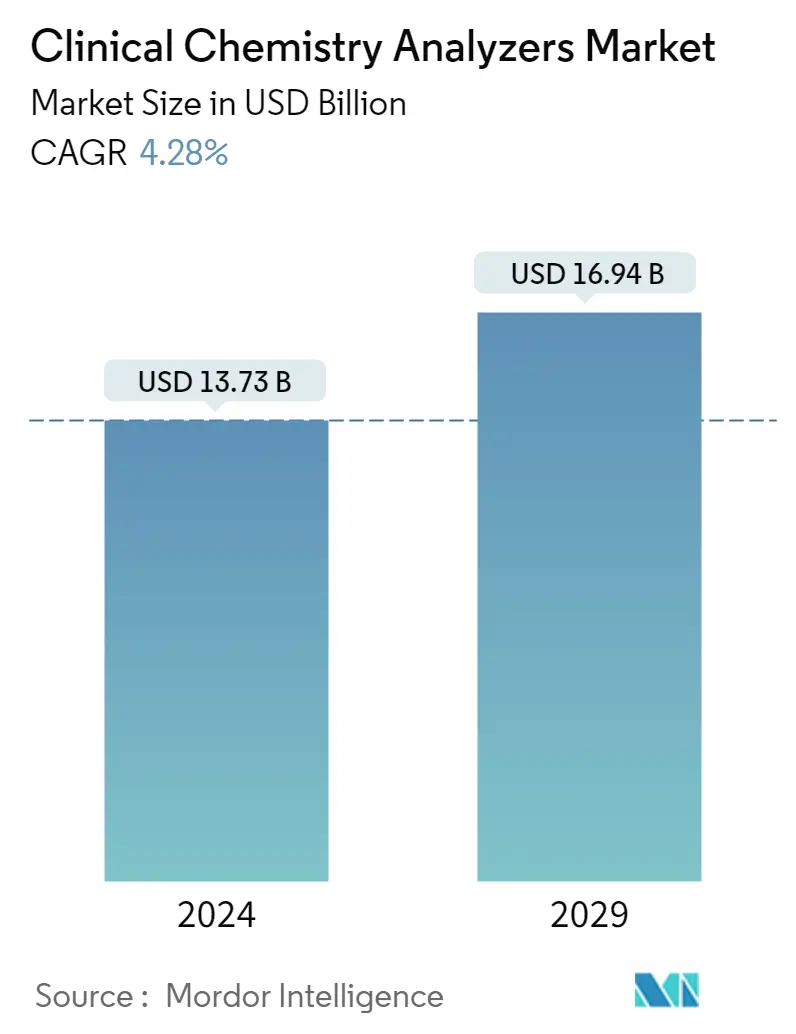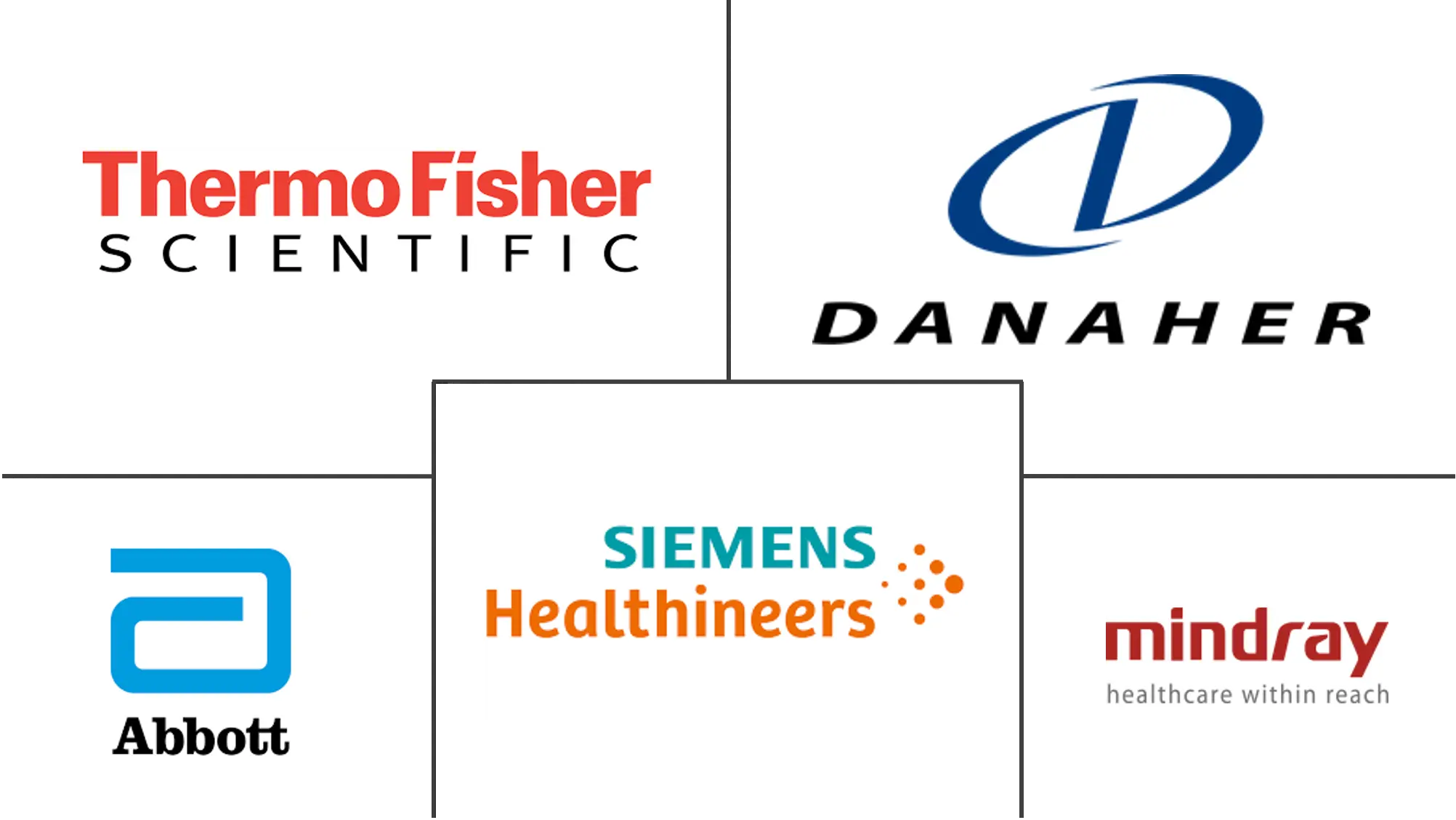Market Size of Clinical Chemistry Analyzers Industry

| Study Period | 2021 - 2029 |
| Market Size (2024) | USD 13.73 Billion |
| Market Size (2029) | USD 16.94 Billion |
| CAGR (2024 - 2029) | 4.28 % |
| Fastest Growing Market | Europe |
| Largest Market | North America |
Major Players
*Disclaimer: Major Players sorted in no particular order |
Clinical Chemistry Analyzers Market Analysis
The Clinical Chemistry Analyzers Market size is estimated at USD 13.73 billion in 2024, and is expected to reach USD 16.94 billion by 2029, growing at a CAGR of 4.28% during the forecast period (2024-2029).
The healthcare system witnessed enormous challenges as a result of the COVID-19 pandemic. All outpatient treatments were postponed or restricted during the COVID-19 pandemic to reduce the risk of viral transmission as most chronic therapies were regarded as non-urgent. However, with the advent of the COVID-19 infection, large-scale clinical chemistry tests for people affected by the SARS-CoV-2 virus were performed. The clinical chemistry tests, along with the serological tests, helped in monitoring the overall health of the affected individuals during the pandemic period. An article published in the Journal of Clinical Chemistry and Laboratory Medicine in April 2020 listed several clinical chemistry tests for patients with COVID-19 in the emergency setting recommended by the IFCC. The tests also consider preanalytical, analytical, and post-analytical variables that can influence the test interpretation. Some of the clinical chemistry tests listed included albumin, lactate dehydrogenase (LD), alanine aminotransferase (ALT), aspartate aminotransferase (AST), and total bilirubin, among others. The increase in the utilization of these tests during the COVID-19 pandemic played a significant role in the growth of the market. However, the stabilizing cases of COVID-19 is expected to bring the clinical chemistry analyzer market at pre-pandemic level over the forecast period.
The major factors for the growth of the clinical chemistry analyzers market include the rising geriatric population, increasing prevalence of chronic diseases, growing importance and awareness of point-of-care testing, and rising technological advancements in clinical chemistry analyzers.
The clinical chemistry analyzers run assays on samples such as blood, plasma, urine, and cerebrospinal fluid to detect the presence of analytes relating to disease or drugs. According to the WHO article on aging and health published in October 2021, by the year 2030, around 1 in 6 people will be over the age of 60. The same source revealed that the number of people over the age of 60 will reach 1.4 billion in the year 2030, up from 1 billion in 2020. The numbers are further projected to rise to 2.1 billion by 2050. Thus, the increasing elderly population is vulnerable to several chronic diseases, resulting in high demand for clinical tests. Thus, the clinical chemistry analyzers market is expected to witness high growth over the forecast period.
Also, the rise in chronic diseases around the world is expected to add to the market's growth. According to the GLOBOCAN 2020 report, the total number of people in the world affected by cancer in 2020 accounted for around 19,292,789 cases. The number is estimated to rise to 28,887,940 cases by 2040. Besides, as per the IDF Diabetes Atlas Tenth Edition 2021, around 537 million adults all over the world were found to have diabetes in 2021, with the numbers projected to grow to 643 million by 2030 and 783 million by 2045. Clinical chemistry analyzers play a vital role in the assessment of such chronic conditions by measuring the lipids, electrolytes, plasma glucose levels, and other profiles of a wide range of components such as blood, serum, plasma, and cerebrospinal fluid, among others. Thus, the rising prevalence of chronic diseases is expected to increase the demand for clinical chemistry analyzers, thereby boosting the market growth.
Moreover, the product launches by the market players are likely to fuel the market's growth. For instance, in July 2022, EDAN Instruments, Inc. launched its POC fluorescence-based CO-OX blood gas and chemistry analysis system, i20, with the capacity to analyze over 45 parameters, covering everything from blood gases to electrolytes to CO-oximetry. Such product launches are expected to propel the growth of the studied market over the forecast period.
However, the lack of trained and qualified professionals and the high cost of clinical chemistry analyzers are expected to hinder the market's growth over the forecast period.
Clinical Chemistry Analyzers Industry Segmentation
As per the scope of this report, clinical chemistry analyzers run assays on clinical samples such as blood, plasma, urine, and cerebrospinal fluid in order to detect the presence of analytes relating to disease or drugs. The Clinical Chemistry Analyzers Market is Segmented by Product Type (Analyzers, Reagents, and Others), Types of Test (Liver Panels, Electrolyte Panels, Thyroid Function Panels, Lipid Profiles, and Others), End User (Hospital, Diagnostic Laboratories, Academic Institutes, and Others), and Geography (North America, Europe, Asia-Pacific, Middle East and Africa, and South America). The Market report also covers the estimated market sizes and trends of 17 countries across major regions globally. The report offers the value (in USD million) for the above segments.
| By Product Type | |
| Analyzers | |
| Reagents | |
| Others |
| By Types of Test | |
| Liver Panels | |
| Electrolyte Panels | |
| Thyroid Function Panels | |
| Lipid Profiles | |
| Others |
| By End User | |
| Hospital | |
| Diagnostic Laboratories | |
| Academic Institutes | |
| Others |
| Geography | ||||||||
| ||||||||
| ||||||||
| ||||||||
| ||||||||
|
Clinical Chemistry Analyzers Market Size Summary
The clinical chemistry analyzers market is poised for significant growth over the forecast period, driven by several key factors. The increasing geriatric population and the rising prevalence of chronic diseases are major contributors to the demand for clinical chemistry tests. These analyzers, which run assays on samples such as blood, plasma, and urine, play a crucial role in detecting disease-related analytes and are essential for managing conditions like diabetes and cancer. The market's expansion is further supported by technological advancements and the growing importance of point-of-care testing. Despite challenges such as the high cost of analyzers and a shortage of trained professionals, the market is expected to thrive, with product innovations and automation in clinical laboratories enhancing efficiency and reducing healthcare costs.
North America is anticipated to be a significant contributor to the market's growth, driven by the high prevalence of chronic diseases and increased healthcare expenditures in the region. The demand for early diagnostics and product innovations by key market players further bolster the market's expansion in this region. The market is characterized by fragmentation, with numerous players such as Abbott Laboratories, Danaher Corporation, and Thermo Fisher Scientific Inc. actively participating. These companies are continually launching advanced products to meet the growing demand. The market's growth trajectory is supported by the ongoing development of new technologies and solutions, which are expected to enhance the capabilities and applications of clinical chemistry analyzers in various healthcare settings.
Clinical Chemistry Analyzers Market Size - Table of Contents
-
1. MARKET DYNAMICS
-
1.1 Market Overview
-
1.2 Market Drivers
-
1.2.1 Rising Geriatric Population and Increasing Prevalence of Chronic Diseases
-
1.2.2 Increasing Importance and Awareness of Point-of-care Testing
-
1.2.3 Rising Technological Advancements in Clinical Chemistry Analyzer
-
-
1.3 Market Restraints
-
1.3.1 Lack of Trained and Qualified Professionals
-
1.3.2 High Cost of Clinical Chemistry Analyzer Equipment
-
-
1.4 Porter's Five Force Analysis
-
1.4.1 Threat of New Entrants
-
1.4.2 Bargaining Power of Buyers/Consumers
-
1.4.3 Bargaining Power of Suppliers
-
1.4.4 Threat of Substitute Products
-
1.4.5 Intensity of Competitive Rivalry
-
-
-
2. MARKET SEGMENTATION (Market Size by Value - in USD Millions)
-
2.1 By Product Type
-
2.1.1 Analyzers
-
2.1.2 Reagents
-
2.1.3 Others
-
-
2.2 By Types of Test
-
2.2.1 Liver Panels
-
2.2.2 Electrolyte Panels
-
2.2.3 Thyroid Function Panels
-
2.2.4 Lipid Profiles
-
2.2.5 Others
-
-
2.3 By End User
-
2.3.1 Hospital
-
2.3.2 Diagnostic Laboratories
-
2.3.3 Academic Institutes
-
2.3.4 Others
-
-
2.4 Geography
-
2.4.1 North America
-
2.4.1.1 United States
-
2.4.1.2 Canada
-
2.4.1.3 Mexico
-
-
2.4.2 Europe
-
2.4.2.1 Germany
-
2.4.2.2 United Kingdom
-
2.4.2.3 France
-
2.4.2.4 Italy
-
2.4.2.5 Spain
-
2.4.2.6 Rest of Europe
-
-
2.4.3 Asia-Pacific
-
2.4.3.1 China
-
2.4.3.2 Japan
-
2.4.3.3 India
-
2.4.3.4 Australia
-
2.4.3.5 South Korea
-
2.4.3.6 Rest of Asia-Pacific
-
-
2.4.4 Middle East and Africa
-
2.4.4.1 GCC
-
2.4.4.2 South Africa
-
2.4.4.3 Rest of Middle East and Africa
-
-
2.4.5 South America
-
2.4.5.1 Brazil
-
2.4.5.2 Argentina
-
2.4.5.3 Rest of South America
-
-
-
Clinical Chemistry Analyzers Market Size FAQs
How big is the Clinical Chemistry Analyzers Market?
The Clinical Chemistry Analyzers Market size is expected to reach USD 13.73 billion in 2024 and grow at a CAGR of 4.28% to reach USD 16.94 billion by 2029.
What is the current Clinical Chemistry Analyzers Market size?
In 2024, the Clinical Chemistry Analyzers Market size is expected to reach USD 13.73 billion.

